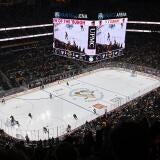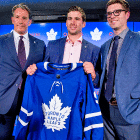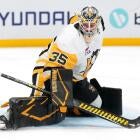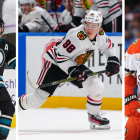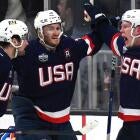NHL team offseason grades: Leafs, Blues and Coyotes get an A; Islanders, Senators flunk out
Grading the offseason moves for all 31 NHL teams
Just like there are winners and losers during the NHL season, there are also winners and losers during the offseason.
While it'll take a while to see how these offseason moves play out on the ice, there are certainly takeaways to be had by judging them on paper. Whether it's via the draft, free agency or trades, a number of teams seem to be in better position than they were at the beginning of the summer. Some are closer to making a run at the Stanley Cup next season, and others are just progressing through a rebuild period.
But, as always, there are losers too. Some teams just can't resist shooting themselves in the foot with bad signings or bad trades, and some just have the misfortune of losing players in free agency.
Let's take a look at what each of the 31 teams have done this summer and hand out grades for their offseason work.
 Anaheim Ducks
Anaheim Ducks
The good: The Ducks have had an offseason that's basically been about addition by subtraction. They got to part ways with some older veteran players who haven't been effective (Francois Beauchemin, Kevin Bieksa, Antoine Vermette) and they can look at turning the page. They also signed Adam Henrique to a five-year extension worth $5.825 million per year. Henrique, 28, has been a consistent offensive contributor -- tallying 20-plus goals in four of the last five seasons. After acquiring him from New Jersey last season, it's a good idea to keep him around.
The bad: Well, when you have an offseason that's about addition by subtraction, that means you're not having an offseason that's about addition by addition. The Ducks' offseason acquisitions (Brian Gibbons, Carter Rowney, Luke Schenn, Andrej Sustr) are nothing to write home about.
Grade: C+
 Arizona Coyotes
Arizona Coyotes
The good: First things first, the Coyotes locked up Oliver Ekman-Larsson with an eight-year, $66 million extension. It's hard to say anything bad about that. And, in what was one of the most shocking deals of the offseason, the Coyotes traded Max Domi to the Montreal Canadiens for Alex Galchenyuk, straight up. That has the potential to be a hell of a one-for-one trade swap. Both players have struggled to meet expectations over the past couple of years and could benefit from the change of scenery, but Galchenyuk has a higher ceiling. He's got boatloads of potential and will have more of a chance to play center and develop his all-around game in Arizona, and that could bring great results. The Yotes also landed Vinnie Hinostroza from Chicago. The 24-year-old forward is a bit undersized and he hasn't put up gaudy numbers, but he's young and he has the potential to be somewhat of a breakout performer if he gets opportunity to spread his wings a bit. Arizona also got depth scoring help in Michael Grabner, who has potted 27 goals in each of the past two seasons.
The bad: Honestly, not a whole lot. They took the Marian Hossa contract from Chicago but they got good compensation for it and can afford the dead money right now. They'll be able to stash him on LTIR during the season and free up some money on the cap if they want to make additional moves to improve around the deadline.
Grade: A
 Boston Bruins
Boston Bruins
The good: They got a solid and relatively young(ish) left-shot defenseman to add to their blue line in 27-year-old John Moore, who came to Boston as a free agent from New Jersey. The five-year commitment it took might seem a bit hefty, but the cap hit comes at a nice price ($2.75 million). Their other additions (backup goalie Jaroslav Halak, forward Chris Wagner) could be decent depth adds but that's about it.
The bad: They lost some valuable depth pieces. By all accounts, Rick Nash is out of the picture and isn't coming back, which might sting a bit given the price the Bruins paid for him at the deadline last year. Riley Nash, a key depth forward, moved on as a free agent. So did Austin Czarnik, Tommy Wingels, Tim Schaller and Nick Holden. The Bruins have some young, promising talent in the pipeline that they're likely hoping can step in to replace these guys. But, as of right now, the Bruins have lost more than they've added. They could still use a proven top-six winger.
Grade: C
 Buffalo Sabres
Buffalo Sabres
The good: They got Rasmus Dahlin, a potential generational talent, with the top overall pick in this summer's NHL Draft. That's especially great because the 18-year-old phenom addresses a position of need on defense. The Sabres also picked up Conor Sheary and Matt Hunwick from the Penguins for pretty much nothing. Sheary is a productive forward (though it should be noted he played alongside Sidney Crosby) and Hunwick is…well, he's a fairly competent body. They took a chance on Carter Hutton, who is coming off a great year in St. Louis. And, speaking of the Blues, they did pretty well getting a decent package for Ryan O'Reilly. More on that below…
The bad: I'm going to list the Ryan O'Reilly trade here in this section just because he's a really good player and the Sabres are probably worse off without him in their lineup, at least in the short term. But it makes complete sense that Buffalo would move on from him -- he's making serious money ($7.5 million AAV through 2023) and the Sabres are rebuilding. He also plays center, where Buffalo has two of their brightest young stars in Jack Eichel and Casey Mittelstadt. So, they dealt O'Reilly to the Blues in exchange for Patrik Berglund and Vladimir Sobotka -- two veteran forwards who have ugly contracts but could be serviceable in a rebuild phase -- plus future assets with a promising prospect in Tage Thompson and two draft picks. That's a decent haul for an expendable piece, but O'Reilly will be missed in Buffalo.
Grade: B+
 Calgary Flames
Calgary Flames
The good: The addition of James Neal (five years, $28.75 million) addresses a desperate need for scoring help, even if the commitment was a bit steep. The 30-year-old is coming off a great season in Vegas (25 goals) and has been a model of consistency during his career, scoring over 20 goals in each of his 10 NHL seasons. Elias Lindholm, who came over in a trade with the Carolina Hurricanes before signing a long-term extension, is a good young player now locked up in Calgary through 2024 at a fair price ($4.85 million). The Flames also picked up center Derek Ryan, who should be a nice depth addition to their bottom-six.
The bad: The Flames parted ways with Dougie Hamilton, who was traded to the Hurricanes in a deal that brought back Lindholm and Noah Hanifin. The subtraction of Hamilton can be look at with a few different lenses; he's an undeniable talent, inarguably one of the best young defensemen in hockey. But Hamilton also has a reputation of being somewhat of a headache and a problem child off the ice. It's why he's been traded twice in the past four years-- from the Bruins to the Flames, and now from the Flames to the Hurricanes. Calgary gets worse on defense swapping Hamilton for Hanifin, but they might get better in the locker room. Unfortunately, that deal also cost them Micheal Ferland -- a very good young forward -- and a stud prospect in Adam Fox. (Though it should be noted that there was/is some speculation Fox plans on playing college hockey until he's eligible to become an unrestricted free agent at the NHL ranks.)
Grade: B-
 Carolina Hurricanes
Carolina Hurricanes
The good: As mentioned above, the addition of Dougie Hamilton -- one of the league's best young defenseman. That's a big-time get if Hamilton can figure out a way to limit his off-ice problems enough to let him stay in once place for more than three years. Ferland is more than just a throw-in on the Hamilton deal, especially if they can get him signed. The Canes also added Calvin de Haan on a very good free agent deal (four years, $18.2 million) and he'll serve as another valuable, reliable piece on the defensive end. In the draft, the Canes got Andrei Svechnikov, who is considered to be one of the two "sure things" from this class. He's considered to be the best forward prospect thanks to his lethal and dynamic offensive game.
The bad: Goaltending is for sure the biggest question mark that remains in Carolina and the Hurricanes haven't done a whole lot to ease those concerns this offseason. Obviously, they're hoping that Scott Darling has a bounce-back year and proves he's capable of being a starter in this league, but -- if he doesn't -- their situation still isn't great behind him. They brought in Petr Mrazek to replace Cam Ward on the depth chart and, honestly, I don't know if it's much of an upgrade.
Grade: A-
 Chicago Blackhawks
Chicago Blackhawks
The good: By all indications, the Blackhawks seemed prepared to make a huge splash either via trade(s) or free agency as they look to get back to being competitive. Maybe it's coming, but -- to this point -- their offseason has been incredibly underwhelming. Their biggest win came when they created immediate cap space by trading Marian Hossa's contract to the Arizona Coyotes, but they haven't used that cap space for anything good yet.
The bad: Well, for starters, even the Blackhawks big win of getting Hossa's contact off the books came paired with a significant loss: They had to throw in Vinnie Hinostroza. They got Marcus Kruger back in that deal but it's still a downgrade. On top of that, the Blackhawks' free agency pickups were worth a head scratch. Cam Ward? Fine, whatever…he's a short-term buy for backup to Corey Crawford. Brandon Manning? No thanks. Chris Kunitz? Good locker room guy but not sure he does much for them considering he's pretty much on his last legs. None of this seems to be helping the Blackhawks get back to winning now, which they seem intent on doing.
Grade: D-
 Colorado Avalanche
Colorado Avalanche
The good: They upgraded at goalie by swapping Jonathan Bernier for Philipp Grubauer, who really emerged as a solid regular presence between the pipes last year in Washington. Grubauer will likely split time with Semyon Varlamov, but the 26-year-old is positioned to take over the starting role after this season when Varlamov's contract runs out. The Avs also parted ways with some UFAs that didn't fit with their youth movement, brought in a needed defensive piece in Ian Cole and depth forward Matt Calvert.
The bad: The Avalanche have one of the most fun and dynamic top lines in the league, and one that basically carried them to a playoff berth last year. They still need more help behind those guys and they haven't done enough to improve on their depth this offseason. They're also still a little questionable defensively, though they've got both Samuel Girard and Cale Makar as very promising youth blue liners in their organization.
Grade: B
 Columbus Blue Jackets
Columbus Blue Jackets
The good: Columbus headed into this offseason needing to improve their forward depth, and they did that. Riley Nash was considered one of the better depth centers available on the market this year, and he brings versatility and reliability to the bottom half of a lineup while also killing penalties. Anthony Duclair has had his development issues but he's a former 20-goal scorer who is still just 22 and it's hard to argue against the $650,000 flyer that Columbus took on him.
The bad: Artemi Panarin's future with the club is still unknown and that's a big cloud to be hanging over the organization. They also lost Ian Cole to free agency and could use some help on defense behind their dominant top pair.
Grade: C
 Dallas Stars
Dallas Stars
The good: They brought in Anton Khudobin to replace Kari Lehtonen as backup goalie, and then made some depth acquisitions in Blake Comeau, Valeri Nichushkin, Roman Polak at relatively OK price points. I suppose you could look at those as positives?
The bad: The Stars seemed hopeful to make a big splash this offseason, but it hasn't happened. Some of the depth players they added will replace ones they lost as UFAs (Antoine Roussel, Dan Hamhuis, Greg Pateryn) so they've sort of just treaded water this offseason.
Grade: C
 Detroit Red Wings
Detroit Red Wings
The good: The Wings kicked off the offseason by snagging Filip Zadina with the sixth pick in the NHL Draft. The Wings were pretty lucky that Zadina fell to them in that spot, as he's arguably the second-best goal scorer of this year's class. Detroit also re-upped Mike Green and Anthony Mantha. In free agency, they reunited with veteran winger Thomas Vanek on a very palatable one-year, $3 million deal.
The bad: The direction of this team is still a bit confusing. They seem a bit stuck in the middle between rebuilding and trying to compete now, and that's not a great place to be. They also committed three years and $9 million to Jonathan Bernier in net, which I'm not sure makes Detroit fans feel any better or more secure about their goaltending situation.
Grade: C+
 Edmonton Oilers
Edmonton Oilers
The good: Heading into this year's draft, one of my favorite prospects on the board was defenseman Evan Bouchard, who went to the Oilers at No. 10. Bouchard brings a very nice all-around game and hockey IQ at a position of need for Edmonton. They also landed Tobias Rieder on a low-risk, one-year deal and added veteran Kyle Brodziak for depth.
The bad: It's hard to say the Oilers got significantly better this offseason, which might be a bit concerning considering how disappointing they were last season. They couldn't find a way to offload Milan Lucic and his monstrous contract, which looks to be one of the worst in the league at this point. But maybe he has a bounce-back year?
Grade: C
 Florida Panthers
Florida Panthers
The good: They landed Mike Hoffman, who was cast off from the Senators. Though Hoffman brings some baggage (the bizarre cyber-bullying story involving his fiancée), he's a good player who should be able to provide a big boost for Florida offensively. And, because of the ugly situation in Ottawa, the Panthers were able to land him for cheap. They also added to the blue line with the addition of Bogdan Kiselevich, who was a KHL All-Star and member of the gold medal-winning Russian Olympic team. Also good news: No expansion draft this summer to royally screw up.
The bad: They're taking a risk on Hoffman considering the circumstances, but other than that it's been a pretty good summer for the Panthers.
Grade: A-
 Los Angeles Kings
Los Angeles Kings
The good: They got much-needed scoring help by adding Ilya Kovalchuk, who makes his much-anticipated NHL return after years in the KHL. Franchise defenseman Drew Doughty was locked up long term with an eight-year, $88 million extension. They also brought back Peter Budaj to help with their backup goalie situation.
The bad: The commitment to Kovalchuk is a pretty significant risk -- three years at $6.25 AAV for a 35-year-old who hasn't seen NHL action in five years. But, again, the Kings desperately needed scoring and Kovalchuk will have a good opportunity beside Anze Kopitar. High-risk, high-reward.
Grade: B
 Minnesota Wild
Minnesota Wild
The good: The most notable addition is Greg Pateryn, who can help provide more depth to the Wild's blue line. They also signed Matt Dumba to a five-year, $30 million extension after a breakout year.
The bad: The most notable addition is Greg Pateryn.
Grade: C-
 Montreal Canadiens
Montreal Canadiens
The good: The Alex Galchenyuk saga is finally over, so I guess that's a plus. They managed to get a young player with upside (Max Domi) in return, and Domi may get back on track with the change of scenery. They also brought back Tomas Plekanec (shocker) and got a nice depth addition in Joel Armia. Picking up Jesperi Kotkaniemi, who might be the best center in this year's draft class, addresses an immediate need for the Habs.
The bad: Even though Domi is still a promising young player, he has a lower ceiling than Galchenyuk and that trade might be the latest that doesn't come up looking so hot for Montreal. The Max Pacioretty cloud is still hanging over the club.
Grade: C
 Nashville Predators
Nashville Predators
The good: The Predators have been extremely quiet this offseason, but they can afford to be since they're one of the league's best teams. They lost Mike Fisher (retirement, again) and Alexei Emelin (UFA) but it has little impact on their standing.
The bad: They've been very boring.
The grade: N/A
 New Jersey Devils
New Jersey Devils
The good: Not much.
The bad: New Jersey had a nice, unexpected year last season, but the Devils were carried by an MVP campaign from Taylor Hall and it was clear that they didn't have the depth to run with the league's legit teams. They've done nothing to change that heading into this year. In fact, they've lost some significant pieces in Patrick Maroon, Michael Grabner, John Moore and Brian Gibbons.
Grade: D-
 New York Islanders
New York Islanders
The good: The offseason got off to a promising start when the Islanders changed their leadership and brought in the well-respected Lou Lamoriello and a head coach fresh off a Stanley Cup win in Barry Trotz. They also had a very promising draft haul, picking up Oliver Wahlstrom (an explosive offensive forward) and Noah Dobson (big, strong two-way defenseman) with back-to-back picks in the first round.
The bad: Just about everything else. Obviously, the loss of John Tavares was the most devastating blow, but there were several other gut punches that followed. They lost Calvin de Haan from their blue line. They signed Leo Komarov to a four-year, $12 million deal -- a contract that has bad news written all over it. Komarov is 31 coming off a season in which he only scored 7 goals and 19 points in 74 games, despite playing more than 15 minutes a night for the Maple Leafs -- the second-best offensive team in the league. They also signed Valtteri Filppula, for some reason. Then they traded to reunite with Matt Martin, who is a fan favorite but not much of a value player outside of the locker room. The response to losing Tavares only served to add salt to the wound.
Grade: F
 New York Rangers
New York Rangers
The good: The Rangers finally parted ways with Alain Vigneault and replaced him with former Boston University head coach David Quinn, who should be a good fit to lead their young, rebuilding roster. Their only add was defenseman Fredrik Claesson, but they also re-upped Jimmy Vesey on a respectable bridge deal.
The bad: There's not a lot to complain about here. The Rangers are in a rebuilding period and have some young players coming up through the system. They'd probably be better off dealing Henrik Lundqvist for a package of future assets, but he doesn't seem to want to go anywhere else.
Grade: C+
 Ottawa Senators
Ottawa Senators
The good: Well, they managed to rid themselves of the toxic situation surrounding Mike Hoffman.
The bad: They didn't even get the best return on a Hoffman trade this summer. After trading him to the Sharks in an underwhelming package that surrounded depth forward Mikkel Boedker, San Jose flipped Hoffman back into Ottawa's division by sending him to Florida for a much better package. On top of that, the Senators haven't worked out the Erik Karlsson situation, which seems beyond repair. It seems inevitable that the Sens are going to get hosed on that one too. The team hasn't done much of anything to improve this offseason and they had to buyout Alex Burrows just one year after giving him a two-year, $5 million extension. Basically, they're a complete mess right now.
Grade: F
 Philadelphia Flyers
Philadelphia Flyers
The good: They landed one of the biggest prizes of this free agent class in James van Riemsdyk, who signed a five-year $35 million deal with Philly. It's a deal that should benefit both sides, as the Flyers are on the upswing and looking to contend while van Riemsdyk will see an increased role in Philly (he averaged under 15 minutes a night in Toronto last season) and can be a major piece in the team's offensive attack.
The bad: They haven't improved their defense at all and until they do it's hard to consider them true contenders. Their current goaltending situation is a bit sketchy (as seems to be tradition in Philly at this point) and if Carter Hart isn't ready to make the jump to the NHL, they might have to seek short-term help in net.
Grade: B+
 Pittsburgh Penguins
Pittsburgh Penguins
The good: The Penguins were already pretty deep at center with Sidney Crosby, Evgeni Malkin and Derick Brassard filling their top six, but they clearly wanted to get even deeper there this offseason. They retained Riley Sheahan, signed Matt Cullen and Derek Grant. Unless they've got trade plans, they're going to enter the season with no worries down the middle.
The bad: They had arguably the worst signing of free agency when they inked Jack Johnson to a five-year, $16.25 million contract.The Pens needed help on the defensive end , but the 31-year-old Johnson hasn't exactly been an impressive blue-line presence (he was a healthy scratch during the Blue Jackets' playoff series) and the metrics suggest he does more bad than good when he's on the ice. Not exactly the kind of guy you want locked up for five years. Making matters worse, the Pens dealt the productive Conor Sheary alongside Matt Hunwick to Buffalo in a cap dump in order to free up space to sign Johnson.
Grade: D-
 St. Louis Blues
St. Louis Blues
The good: The Blues have had quite an impressive summer. They've gotten strong down the middle with the additions of Ryan O'Reilly, who came over in a deal with Buffalo, and free agent signing Tyler Bozak. Now, the Blues will feature Brayden Schenn, O'Reilly and Bozak down the middle in their impressive top six, which will also feature David Perron and Patrick Maroon -- both signed this offseason. Their offensive attack should be impressive and deep.
The bad: The Blues still have goaltending concerns. Jake Allen is coming off a year that didn't inspire much confidence in him as the starter, and St. Louis had to downgrade in the backup spot when Carter Hutton departed for Buffalo. If Allen struggles again this year, the Blues will have to turn to Chad Johnson, which is certainly not ideal.
Grade: A
 San Jose Sharks
San Jose Sharks
The good: San Jose managed to retain Evander Kane, even if it took a major commitment in both years and dollars (seven years, $49 million). Kane seemed to be a really good fit in San Jose after being traded out west during last season. The Sharks also brought back Joe Thornton on a one-year deal. They also shrewdly flipped Mike Hoffman to Florida and picked up a pretty decent package of three draft picks.
The bad: They seemed to putt all their eggs in the baskets of John Tavares and Ilya Kovalchuk, and narrowly missed out on both free agent prizes. As a result, they didn't improve much via addition this offseason. That being said, they didn't really have to.
Grade: C
 Tampa Bay Lighting
Tampa Bay Lighting
The good: Nikita Kucherov isn't going anywhere. The elite winger signed an eight-year, $76 million extension with the Lightning this offseason – another bargain deal to keep Tampa's core in tact. They also extended Ryan McDonagh for seven years, which is a deal that may look rough down the line but helps them as they look to win a Cup right now. Depth forward Andy Andreoff came over in a trade with the Kings.
The bad: Other than the extensions and minor addition of Andreoff, the Lightning have been awfully quiet. They've been linked to Erik Karlsson but trade talks seem to have cooled on that front, and they haven't really improved anywhere this summer. The good news is they haven't lost much (just Chris Kunitz and Andrej Sustr) and still remain one of the best teams in the league.
Grade: B
 Toronto Maple Leafs
Toronto Maple Leafs
The good: John Tavares John Tavares John Tavares John Tavares John Tavares John Tavares John Tavares John Tavares John Tavares John Tavares John Tavares John Tavares John Tavares John Tavares John Tavares John Tavares John Tavares.
The bad: Only one John Tavares. (Also, lost James van Riemsdyk and still need defensive help.)
Grade: A
 Vancouver Canucks
Vancouver Canucks
The good: They really need an impact player on defense and they may have gotten one in Quinn Hughes, who they selected with the seventh overall pick in this year's draft. They also boosted the back end of their lineup with the additions of Antoine Roussel, Jay Beagle and Tim Schaller.
The bad: While Beagle and Roussel are decent depth players, they're not the kind of players you want to commit to for four years and $12 million. That's exactly what the Canucks did for each of them, which doesn't make a whole lot of sense – especially for a team that's still in the middle of a rebuild. Teams often have to give a little extra on term or money to lure free agents, but Vancouver is shelling out too much on both ends, and for players who aren't major difference makers. The Canucks need to focus on front-end talent before over-committing to the back end.
Grade: F
 Vegas Golden Knights
Vegas Golden Knights
The good: The Knights bolstered their second line by signing Paul Stastny to a three-year, $19.5 million deal. It might be a slight overpayment, but Stastny is a versatile, veteran playmaker who improves Vegas down the middle. Plus, the Golden Knights can afford to overpay, especially if means stealing Stastny away from Winnipeg. They also extended Marc-Andre Fleury, who was the single biggest reason for the Knights' run to the Stanley Cup Final last year.
The bad: That Fleury extension (three years, $21 million) has potential to look terrible. He'll be 35 years old when it kicks in and he projects to be the third-highest-paid goalie in the league at that point. That's putting a lot of faith in an aging goalie with a career save-percentage of .913. Vegas also lost James Neal and David Perron, two veteran wingers who were productive during Vegas' inaugural season. Losing their goal scoring might sting.
Grade: C+
 Washington Capitals
Washington Capitals
The good: They managed to keep John Carlson, who is coming off a career year as a dynamic player on their blue line. He was a big part of last season's Stanley Cup win and he parlayed it into a new eight-year, $64 million contract. They managed to get out from the final year of Brooks Orpik's deal and free up some cap room. Also, nobody perished in the Caps' summer-long Cup bender. Take the victories where you can get them.
The bad: They lose a damn good insurance policy in Philipp Grubauer, the backup goalie who was traded to Colorado along with Orpik. They also lose Jay Beagle from their fourth line, which isn't a killer but he was a decent depth piece. They haven't added much of anything, but they haven't lost much either. Considering they're the Stanley Cup champs, it's not the worst thing in the world.
Grade: B
 Winnipeg Jets
Winnipeg Jets
The good: Jacob Trouba's arbitration ruling came in at $5.5 million, which is a pretty solid bargain for another year of the young defenseman.
The bad: They haven't added much of anything. They lost Paul Stastny to the Golden Knights, and did so after trading Joel Armia in order to free up money for Stastny. That's a gut punch, especially considering how well Stastny fit in centering their second line. It won't help the "nobody wants to go play in Winnipeg" narrative, either.
Grade: D




